Soft gelatin capsules are important for daily health. They range from omega-3 supplements to advanced drug delivery systems. They feature a smooth surface and an easy-to-swallow form. As the demand for softgels grows in both the pharmaceutical and nutritional industries, many supplement manufacturers choose to produce softgels.
Four key ingredients used in softgel manufacturing
When making soft capsules, you have to prepare the necessary ingredients for production. It not only smooths the making process but also lets you know how much budget you should prepare.
Gelatin
Gelatin is the main ingredient in softgel making. It is used to form the outer shell of soft gelatin capsules. Gelatin is a natural protein derived mainly from animal sources such as bovine, porcine, or fish skin. The type and quality of gelatin can affect the texture, strength, and dissolution rate of the capsule. There are two main types of gelatin in the market.
- Type A gelatin. It is produced through acid processing, usually from pig skin. With a lower bloom strength, it is often used in certain pharmaceutical applications, like medicine for fever relief.
- Type B gelatin. It is derived through alkaline processing, typically from bovine hide or bone. It offers higher bloom strength and it is more common in general softgel production.
You can choose the gelatin type based on your production need and regulatory restrictions. Some manufacturers also offer fish-based gelatin as a non-pork, non-beef alternative for specific cultural or religious markets.
Plasticizers
Plasticizers are added to gelatin to make the capsule shell soft, flexible, and elastic. They reduce brittleness and help the shell maintain its shape during encapsulation. The most commonly used plasticizers include
- Glycerin. It is widely used in pharmaceutical softgels. This material provides good flexibility but attracts moisture.
- Sorbitol or sorbitol mixtures. It is often used in combination with glycerin to reduce stickiness. This improves shell stability in humid environments.
- Propylene glycol. Sometimes it is used for specific formulations, though less common due to regulatory limits.
During manufacturing, the ratio of gelatin to plasticizer is crucial. It directly affects the capsule’s texture, drying time, and storage stability.
Water and coloring agents
Water is essential to prepare the gelatin mass. It helps dissolve gelatin and plasticizers and creates the right viscosity to form the capsule shell. After filling, most of the water evaporates during the drying stage. Then you get stable and flexible shells.
Coloring agents may be added for more attraction, branding, or to protect light-sensitive ingredients. Colors can be natural from plant extracts or synthetic. The former leads a better effect but costs much higher.
Filling materials
The inside of the softgel contains the active substance dissolved or suspended in a suitable base. Filling materials can vary depending on the type of product. Common types include
- Oils. Common oils include soybean oil, olive oil, or medium-chain triglycerides (MCT). These are popular carriers for fat-soluble vitamins like A, D, and E.
- Suspensions. They mean fine powders dispersed in oil or another medium. These are used when the active ingredient does not dissolve well in oil.
- Emulsions. They are oil and water mixtures stabilized by emulsifiers. These allow both water-soluble and oil-soluble actives to be delivered together.
When selecting the filling materials, they must work well with the gelatin shell. It prevents problems like leaking, breaking down, or becoming too soft.
Five popular machines used to make softgels
There are many softgel encapsulation machines to help you fill soft capsules. Here are some choices for your reference.
Automatic rotary die softgel encapsulation machine
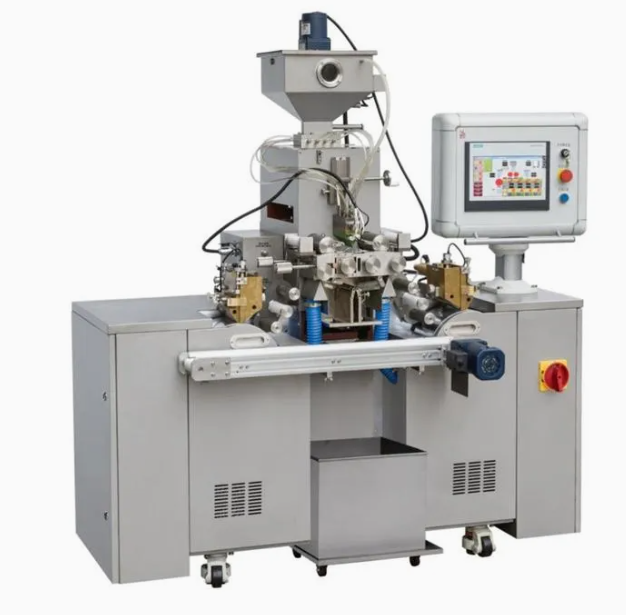
This is the most widely used machine in softgel manufacturing. It uses two rotating dies with matching cavities to form, fill, and seal the soft gelatin capsules in a continuous process. It features high-speed production and flexible applications. This can handle a wide range of fill materials to meet your production needs. This equipment is always used for large-volume production.
However, a rotary die softgel making machine costs high. In addition, it requires skilled operators and good maintenance. This also increases the cost.
Semi-automatic softgel making machine
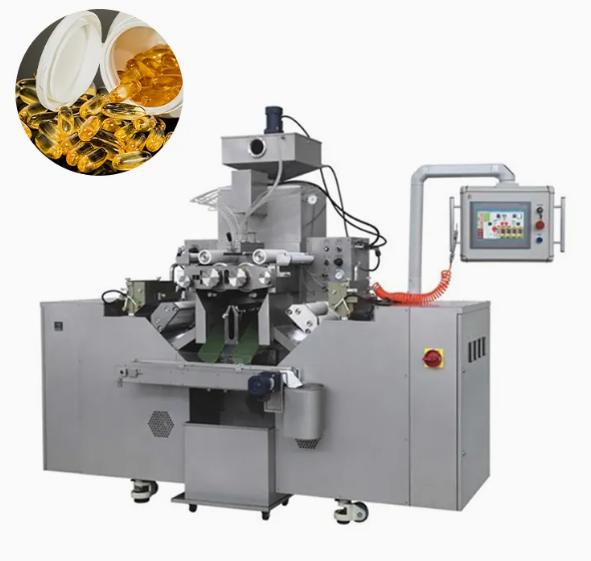
A semi-automatic softgel encapsulation machine is designed as a middle-ground option between manual and fully automatic systems. It includes some automated components, typically the fill material injection and capsule sealing system. It also requires some manual handling, such as material feeding and alignment for die rolls. This model suits those who want efficiency but lower cost.
Veggie softgel encapsulation machine
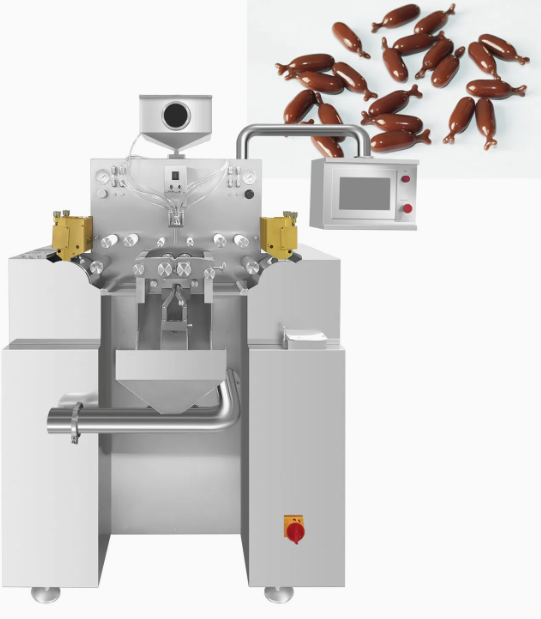
This equipment is specially designed to work with non-gelatin ingredients like HPMC or starch. It targets vegetarian, vegan, halal, or kosher capsules. However, this machine is more sensitive to processing conditions. It also costs much more than gelatin softgel-making equipment.
Laboratory or R&D softgel encapsulation machine
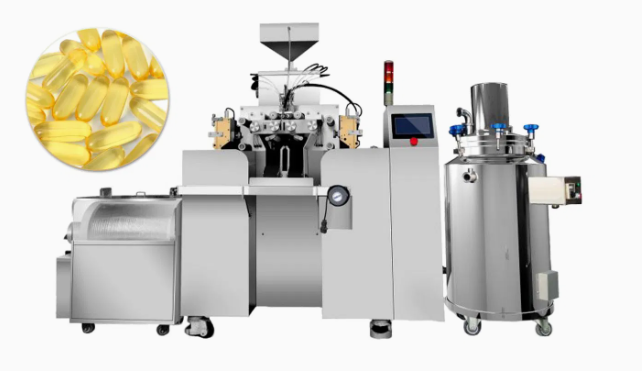
This is a smaller version of the rotary die machine. It is made for product development and small-scale production, like reseach in a lab. This equipment typically shares the same working principle as the industrial ones, but at a lower speed and volume. It suits manufacturers who run a small-scale business or have a tight budget.
Automatic softgel encapsulation line
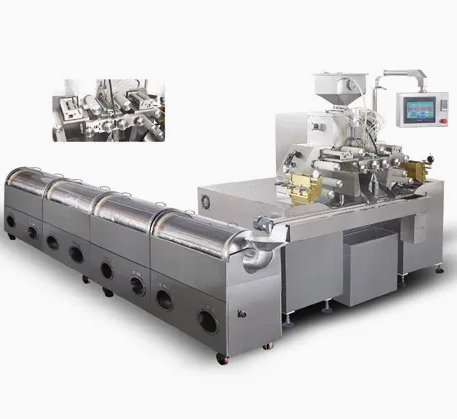
A full production line includes not just the encapsulation machine, but also support systems. It always involves gelatin melting tanks, fill material preparation tanks, tumble dryers, and drying tunnels. This line is fully integrated for continuous production, ideal for large-scale manufacturers. It also greatly reduces manual handling and contamination risk.
Six main steps in softgel manufacturing process
Gel mass preparation
At first, you need to prepare the gelatin mass to form the capsule shell. You should mix gelatin with plasticizers and purified water in a container like a large stainless steel tank. Then, heat the mixture and stir it until it becomes a thick, clear, and sticky liquid.
This gel mass should be kept at a controlled temperature, usually between 60°C to 70°C, to maintain its fluidity. Once fully mixed, the mass is transferred to insulated holding tanks. It would be kept warm until it’s ready for use in encapsulation.
Filling material preparation
While the gelatin mass is being prepared, the filling material is also made. This is the liquid or semi-liquid that will go inside the softgel. The filling material may contain oils, suspensions, or emulsions with the active ingredients, such as vitamins, herbal extracts, or medicines.
When choosing the formulation, a stable one is needed. It also should have the right viscosity to ensure smooth flow into the capsule. The filling ingredients are usually mixed in a separate vessel. Next, they pass through a filtration system to remove impurities or large particles. The filling material is kept under nitrogen in some cases to prevent oxidation.
Encapsulation process
Most softgel capsules are made with the rotary die method. This is a widely used and efficient technique. During this process, the warm gelatin mass is formed into two thin ribbons by heated rollers. These ribbons are then fed into a rotary die machine. They would pass through two rotating dies with matching mold cavities.
At the same time, the filling material is injected between the two gelatin ribbons. As the die rolls turn, the ribbons are sealed around the filling material and cut into individual capsules.
Drying
Freshly formed softgel capsules are soft and sticky. They need to be dried to remove excess moisture and become firm and stable. First, the capsules are sent through a tumble dryer. Then, they are placed in drying trays and moved to a drying tunnel with controlled temperature and humidity.
This drying process can take from 24 to 72 hours. It mainly depends on the capsule size, formulation, and environment.
Inspection and sorting
After drying, softgels are inspected for quality control. It would remove capsules that are deformed, leaking, or underfilled. This can be done manually or with automated vision systems.
Sorting machines may also be used to separate capsules by size, weight, or appearance. Soft capsules that do not meet quality standards are rejected and discarded or recycled if possible.
Packing
Once the capsules pass inspection, they are ready for packaging. Depending on the final product, softgels may be:
- Bottled in plastic containers or glass jars.
- Packed in blister packs, often used for pharmaceutical products.
- Filled into sachets or strips.
During packaging, soft capsules may go through additional steps like printing or polishing to improve appearance. Each package is also labeled according to regulatory requirements, such as product information, expiration date, brand, etc. Moreover, samples are usually kept for stability testing and traceability.
The end
As the demand for softgels grows, it is a good time to join this business. A clear understanding of the full softgel making process can help you make better choices and improve production efficiency.